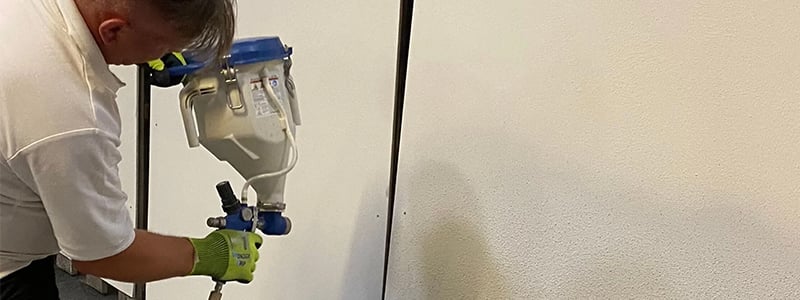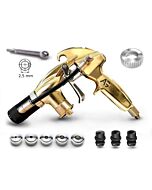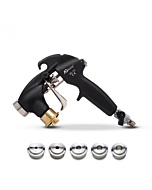What are the benefits to use rendering units for mechanical applying adhesives, primers and thin coat renders like silicone render?

Using rendering units for mechanically applying adhesives, primers, and thin thin coat renders in construction and insulation systems offers several benefits:
Consistency and Precision:
Mechanical application ensures a consistent and precise distribution of adhesives, primers, and thin coat renders. This helps achieve a uniform layer, minimizing variations that may occur with manual application.
Time Efficiency:
Mechanical rendering units can cover larger areas more quickly than manual methods. This increases the efficiency of the application process, making it suitable for both small and large-scale projects.
Labor Savings:
The use of rendering units reduces the need for manual labor in the application process. This can lead to labor savings, as fewer workers may be required for the same amount of work compared to traditional application methods.
Reduced Physical Strain:
Manual application of adhesives, primers, and renders can be physically demanding. Using mechanical rendering units helps reduce the physical strain on workers, contributing to a safer and more comfortable working environment.
Optimal Material Consumption:
Mechanical application systems are designed to optimize the use of materials, reducing waste. This can lead to cost savings and a more sustainable construction process.
Improved Adhesion and Performance:
Mechanical application can enhance the bonding of adhesives and primers to the substrate, leading to improved adhesion and overall performance of the applied materials.
Versatility:
Rendering units are often designed to handle a variety of materials, making them versatile for different applications. This versatility allows for the use of various adhesives, primers, and thin coat renders with the same equipment.
Quality Control:
Mechanized systems often come with features that allow for better quality control. Parameters such as application thickness and material consistency can be monitored and adjusted more precisely, ensuring a high-quality finish.
Adaptability to Surface Conditions:
Mechanical rendering units can be adjusted to accommodate different types of surfaces, ensuring proper application on various substrates with different textures and properties.
Cost-Effectiveness in the Long Run:
While the initial investment in rendering units may be higher, the overall cost-effectiveness often comes into play over the long run due to increased efficiency, labor savings, and reduced material waste.
It's important to note that the specific benefits may vary depending on the type of rendering unit used, the characteristics of the materials being applied, and the requirements of the construction project.
Related Products
-
![Professional plastering spraying machine 20L]() Professional plastering spraying machine 20L£1,089.60 / set £908.00 / set£933.97 / set£778.31 / set
Professional plastering spraying machine 20L£1,089.60 / set £908.00 / set£933.97 / set£778.31 / set -
![Silicone Render Atlas Hybrid]() Silicone render Atlas Hybrid SAH N15 1.5mm 25kg£56.28 / bucket £46.90 / bucket£48.24 / bucket£40.20 / bucket
Silicone render Atlas Hybrid SAH N15 1.5mm 25kg£56.28 / bucket £46.90 / bucket£48.24 / bucket£40.20 / bucket -
![silicone-render-AZURO-SEMPRE-dotted-1.5mm]() Silicone render AZURO dotted 1.5mm white 25kg£64.18 / bucket £53.48 / bucket£55.01 / bucket£45.84 / bucket
Silicone render AZURO dotted 1.5mm white 25kg£64.18 / bucket £53.48 / bucket£55.01 / bucket£45.84 / bucket -
![Industrial plastering set AK10 PRO GOLD 20L]() Industrial plastering set AK10 PRO GOLD 20L£1,470.47 / set £1,225.39 / set£1,260.44 / set£1,050.37 / set
Industrial plastering set AK10 PRO GOLD 20L£1,470.47 / set £1,225.39 / set£1,260.44 / set£1,050.37 / set -
![Professional plastering unit AGREKOM 60L]() Professional plastering unit AGREKOM 60L£2,183.68 / set £1,819.73 / set£1,871.78 / set£1,559.82 / set
Professional plastering unit AGREKOM 60L£2,183.68 / set £1,819.73 / set£1,871.78 / set£1,559.82 / set -
![Plastering unit for semi-professional use 20 l]() Semi-professional plastering and rendering unit AGREKOM 20L£920.40 / set £767.00 / set£788.94 / set£657.45 / set
Semi-professional plastering and rendering unit AGREKOM 20L£920.40 / set £767.00 / set£788.94 / set£657.45 / set -
![Acrylic render TESORO dotted 1.5 mm white 25 kg]() Acrylic render TESORO dotted 1.5 mm white 25 kg£47.41 / bucket £39.51 / bucket£40.64 / bucket£33.87 / bucket
Acrylic render TESORO dotted 1.5 mm white 25 kg£47.41 / bucket £39.51 / bucket£40.64 / bucket£33.87 / bucket
Search for content
Post categories


















